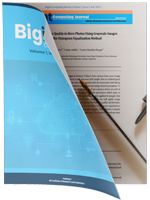Optimization of Official Correspondence Management with Google Sheets
DOI:
https://doi.org/10.55537/bigint.v3i2.1137Keywords:
Mail Administration, Google Sheets, Efficiency, College, Digital SystemAbstract
Administrative management of letters in higher education environments still often faces various obstacles, especially if they are still using manual methods. At the Faculty of Tarbiyah and Teacher Training UINSU, the old system often causes delays in processing, errors in letter numbering, and difficulties when searching for archives. This study aims to see how the implementation of Google Sheets can help optimize digital letter management. The method used is descriptive qualitative, with data collected through direct observation and interviews with four administrative staff from three different divisions. The analysis was carried out using a thematic coding approach and inductive content. The results of the study showed a significant increase: the time for recording letters was reduced by 60%, searching for archives became 80% faster, and archiving time was also reduced by 80%. Numbering accuracy increased thanks to the automation feature, while transparency between units improved because all data could be accessed together in real time. In addition, the use of Google Sheets reduces operational costs because it does not require additional devices or software. From these findings, it can be concluded that Google Sheets is a simple but effective digital tool to help the administration process become more efficient, accurate, and transparent. This model also has the potential to be applied to other administrative units that are looking for practical solutions in the digitalization process.
Downloads
References
T. Dewett and G. R. Jones, "The role of information technology in the organization: A review, model, and assessment," Journal of Management, vol. 27, no. 3, pp. 313–346, 2001.
K. L. Lee, P. N. Romzi, J. R. Hanaysha, H. M. Alzoubi, and M. T. Alshurideh, “Investigating the impact of benefits and challenges of IoT adoption on supply chain performance and organizational performance: An empirical study in Malaysia,” Uncertain Supply Chain Management, vol. 10, pp. 537–550, 2022, doi: 10.5267/j.uscm.2021.11.009.
M. Al-Okaily, “Assessing the effectiveness of accounting information systems in the era of COVID-19 pandemic,” VINE Journal of Information and Knowledge Management Systems, vol. 51, no. 4, pp. 588–610, Dec. 2021, doi: 10.1108/VJIKMS-08-2021-0148.
J. Díaz-García, M.-D. González-Zamar, and E. Abad-Segura, “Managing Digital Transformation: A Case Study in a Higher Education Institution,” Electronics, vol. 12, no. 11, p. 2522, 2023, doi: 10.3390/electronics12112522.
L. M. C. Benavides, J. A. T. Arias, D. Burgos, and A. Martens, “Measuring digital transformation in higher education institutions – content validity instrument,” Applied Computing and Informatics, vol. 18, no. 3, pp. 379–399, 2022, doi: 10.1108/ACI-03-2022-0069.
W. Kayanja, M. Kyambade, dan T. Kiggundu, “Exploring digital transformation in higher education setting: the shift to fully automated and paperless systems,” Cogent Education, vol. 12, no. 1, 2025, doi: 10.1080/2331186X.2025.2489800.
J. Meers, S. Halliday, and J. Tomlinson, “An ‘interface first’ bureaucracy: Interface design, universal credit and the digital welfare state,” Social Policy & Administration, vol. 59, no. 1, pp. 119–134, 2025, doi: 10.1111/spol.13053.
M. S. Grønkjær, P. Elsborg, C. J. Lau, M. Bekker-Jeppesen, N. Gøtzsche, M. H. Jacobsen, A. H. Andreasen, and M. H. Eliasen, “Survey administration and participation: a randomized trial in a panel population health survey,” BMC Medical Research Methodology, vol. 25, no. 119, 2025, doi: 10.1186/s12874-025-02578-2.
J. Huh, “Letter to the Editor Standards,” Journal of Korean Medical Science, vol. 40, no. 35, p. e261, Sep. 2025, doi: 10.3346/jkms.2025.40.e261.
J. Meers, S. Halliday, and J. Tomlinson, “An ‘interface first’ bureaucracy: Interface design, universal credit and the digital welfare state,” Social Policy & Administration, vol. 59, no. 1, pp. 119–134, 2025, doi: 10.1111/spol.13053.
A. A. Aziz, Z. M. Yusof, U. A. Mokhtar, and D. I. Jambari, “The Implementation Guidelines of Digital Document Management System for Malaysia Public Sector: Expert Review,” International Journal on Advanced Science, Engineering and Information Technology, vol. 10, no. 1, pp. 198–204, 2020, doi: 10.18517/ijaseit.10.1.10443.
D. Alvarez-Sández, K. Velázquez-Victorica, A. Mungaray-Moctezuma, and A. López-Guerrero, “Administrative Processes Efficiency Measurement in Higher Education Institutions: A Scoping Review,” Education Sciences, vol. 13, no. 9, p. 855, 2023, doi: 10.3390/educsci13090855.
A. Pietropaolo et al., “Economic burden of imaging and interventions in endourology: A worldwide cost analysis from European Association of Urology Young Academic Urology Endourology and Urolithiasis Working Party,” J. Endourol., vol. 39, no. 4, pp. 389–398, Feb. 2025, doi: 10.1089/end.2024.0673.
Ramesh, B. A., Viswanathan, S., Manjunath, S., Fernandez, D. D., Priyadarshini, C., & Shetty, G. B. (2019). Innovative methods of maintaining operation records using the online Google spreadsheet. Formosan Journal of Surgery, 52(2), 66-69.
O. D. Adebagbo, A. Girardi, H. S. Quinn, and L. Guo, “The influence of dedicated research year on applicant familiarity in the integrated plastic surgery match,” J. Surg. Educ., vol. 82, no. 5, p. 103478, May 2025, doi: 10.1016/j.jsurg.2025.103478.
S. Sternad Zabukovšek, S. Jordan, and S. Bobek, “Managing document management systems’ life cycle in relation to an organization’s maturity for digital transformation,” Sustainability, vol. 15, no. 21, p. 15212, Oct. 2023, doi: 10.3390/su152115212.
F. Parra, A. Jacobs, and L. L. Trevino, “Shippy Express: Augmenting accounting education with Google Sheets,” J. Account. Educ., vol. 56, p. 100740, Jun. 2021, doi: 10.1016/j.jaccedu.2021.100740.
T. Yalcinkaya, E. Ünsal, A. Dönmez, and S. C. Yucel, “'I would like to use it more effectively…' nursing student’s experiences with NANDA-I nursing terminology: a qualitative descriptive study,” BMC Nursing, vol. 24, no. 55, 2025, doi: 10.1186/s12912-025-02724-7.
X. Wan, D. N. S. Chan, J. P. C. Chau, Y. Zhang, Z. Gu, and L. Xu, “Social participation challenges and facilitators among Chinese stroke survivors: a qualitative descriptive study,” BMC Public Health, vol. 25, no. 468, 2025, doi: 10.1186/s12889-025-21592-z.
L. Chen, C. Xu, and Y. Zhou, “Clinical internship experience of African undergraduate nursing students in China: a descriptive qualitative study,” BMC Med. Educ., vol. 25, no. 245, 2025, doi: 10.1186/s12909-025-06860-1.
Downloads
Published
How to Cite
Issue
Section
License
Copyright (c) 2025 Rifki Ade Ananda, Moses Adeolu Agoi, Muhammad Yasin Simargolang

This work is licensed under a Creative Commons Attribution-ShareAlike 4.0 International License.




